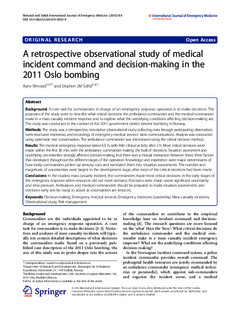| dc.contributor.author | Rimstad, Rune | |
| dc.contributor.author | Sollid, Stephen JM | |
| dc.date.accessioned | 2016-01-08T12:30:25Z | |
| dc.date.available | 2016-01-08T12:30:25Z | |
| dc.date.issued | 2015 | |
| dc.identifier.citation | Rimstad, R., Sollid, SJM (2015) A retrospective observational study of medical incident command and decision-making in the 2011 Oslo bombing. International journal of emergency medicine, 8(4) | nb_NO |
| dc.identifier.uri | http://hdl.handle.net/11250/2373067 | |
| dc.description | © 2015 Rimstad and Sollid; licensee Springer. This is an Open Access article distributed under the terms of the Creative
Commons Attribution License (http://creativecommons.org/licenses/by/4.0), which permits unrestricted use, distribution, and
reproduction in any medium, provided the original work is properly credited. The article was originally published in the International Journal of Emergency Medicine. | nb_NO |
| dc.description.abstract | Background: A core task for commanders in charge of an emergency response operation is to make decisions. The
purposes of the study were to describe what critical decisions the ambulance commander and the medical commander
make in a mass casualty incident response and to explore what the underlying conditions affecting decision-making are.
The study was conducted in the context of the 2011 government district terrorist bombing in Norway.
Methods: The study was a retrospective, descriptive observational study collecting data through participating observation,
semi-structured interviews, and recordings of emergency medical services’ radio communications. Analysis was conducted
using systematic text condensation. The ambulance commander was interviewed using the critical decision method.
Results: The medical emergency response lasted 6.5 h, with little clinical activity after 2 h. Most critical decisions were
made within the first 30 min, with the ambulance commander making the bulk of decisions. Situation assessment and
underlying uncertainties strongly affected decision-making, but there was a mutual interaction between these three factors
that developed throughout the different stages of the operation. Knowledge and experience were major determinants of
how easily commanders picked up sensory cues and translated them into situation assessments. The number and
magnitude of uncertainties were largest in the development stage, after most of the critical decisions had been made.
Conclusions: In the studied mass casualty incident, the commanders made most critical decisions in the early stages of
the emergency response when resources did not meet demand. Decisions were made under significant uncertainty
and time pressure. Ambulance and medical commanders should be prepared to make situation assessments and
decisions early and be ready to adjust as uncertainties are reduced. | nb_NO |
| dc.language.iso | eng | nb_NO |
| dc.publisher | Springer | nb_NO |
| dc.rights | Navngivelse 3.0 Norge | * |
| dc.rights.uri | http://creativecommons.org/licenses/by/3.0/no/ | * |
| dc.subject | emergency medicine | nb_NO |
| dc.subject | emergency medical services | nb_NO |
| dc.subject | akuttmedisin | nb_NO |
| dc.subject | leadership | nb_NO |
| dc.subject | risk management | nb_NO |
| dc.subject | risikostyring | nb_NO |
| dc.subject | decision-making | nb_NO |
| dc.subject | observational study | nb_NO |
| dc.subject | ledelse | nb_NO |
| dc.title | A retrospective observational study of medical incident command and decision-making in the 2011 Oslo bombing | nb_NO |
| dc.type | Journal article | nb_NO |
| dc.type | Peer reviewed | nb_NO |
| dc.subject.nsi | VDP::Medical disciplines: 700 | nb_NO |
| dc.source.volume | 8 | nb_NO |
| dc.source.journal | International journal of emergency medicine | nb_NO |
| dc.source.issue | 4 | nb_NO |
| dc.identifier.doi | 10.1186/s12245-015-0052-9 | |

